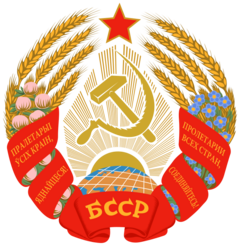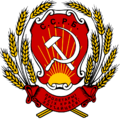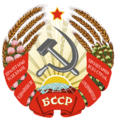Communist Party of Byelorussia facts for kids
Quick facts for kids
Communist Party of
Byelorussia Камуністычная партыя Беларусі
|
|
|---|---|
 |
|
| Founded | 30–31 December 1917 |
| Banned | 25 August 1991 |
| Succeeded by | Party of Belarusian Communists |
| Ideology | Communism Marxism–Leninism |
| Political position | Far-left |
| National affiliation | Communist Party of the Soviet Union |
| International affiliation | Comintern (until 1943) Cominform (until 1956) |
| Colours | Red |
| Slogan | Workers of the world, unite! |
| Anthem | The Internationale Anthem of Byelorussian SSR |
| Party flag | |
 |
|
The Communist Party of Byelorussia (CPB) was a major political party in the Byelorussian Soviet Socialist Republic. This republic was a part of the Soviet Union from 1922. The party existed from 1917 until 1991. It played a very important role in how Byelorussia was governed during this time.
History of the Party
The party started in 1917. It was first called the Communist Party (Bolsheviks) of Byelorussia. This happened after the Russian Revolution of 1917. It was part of the larger Russian Communist Party (bolsheviks) led by Vladimir Lenin. When it began in December 1918, it had about 17,800 members.
The CPB was key in creating the Byelorussian Soviet Republic in January 1919. For a short time, from 1919 to 1920, it worked together with the Communist Party of Lithuania. They were known as the Communist Party (Bolsheviks) of Lithuania and Belorussia. The party's name changed to the Communist Party of Byelorussia in 1952.
How the Party Worked
The CPB was a communist party. It followed a rule called democratic centralism. This meant that members could openly discuss ideas and policies. But once a decision was made, everyone had to support it fully.
The most important group in the CPB was the Party Congress. It met every five years. When the Congress was not meeting, the Central Committee made the big decisions. For daily tasks, a smaller group called the Politburo (or Presidium) and the Secretariat handled things.
The party leader was usually the head of the government. This person was often called the General Secretary. They were the main leader of the CPB and the Byelorussian Republic. The party's main idea was Marxism–Leninism. This was a mix of ideas from Karl Marx and Lenin. Joseph Stalin later made it the official guiding idea for the party.
Challenges and Changes
In the 1930s, the Communist Party of Byelorussia faced a tough period. Many important leaders and about 40% of all members were removed from their positions. This happened during a time known as Stalin's purges. These events stopped many social and cultural improvements that had started in the 1920s. This affected Byelorussian culture and society for a long time. The year 1937 was especially difficult for the party.
On July 28, 1990, a change was made to the Constitution of the Byelorussian SSR. It removed the rule that said the Communist Party of Byelorussia was the only party allowed to have power.
From August 25, 1991, to February 3, 1993, the party's activities were stopped. Then, on April 25, 1993, the party decided to join with the Party of Communists of Belarus (PCB).
See also
- Belarusian United Left Party "A Just World"
- Communist Party of Belarus
Images for kids
-
Panteleimon Ponomarenko, First Secretary (1938–1947)
-
Kirill Mazurov, First Secretary (1956–1965)
-
Pyotr Masherov, First Secretary (1965–1980)



















